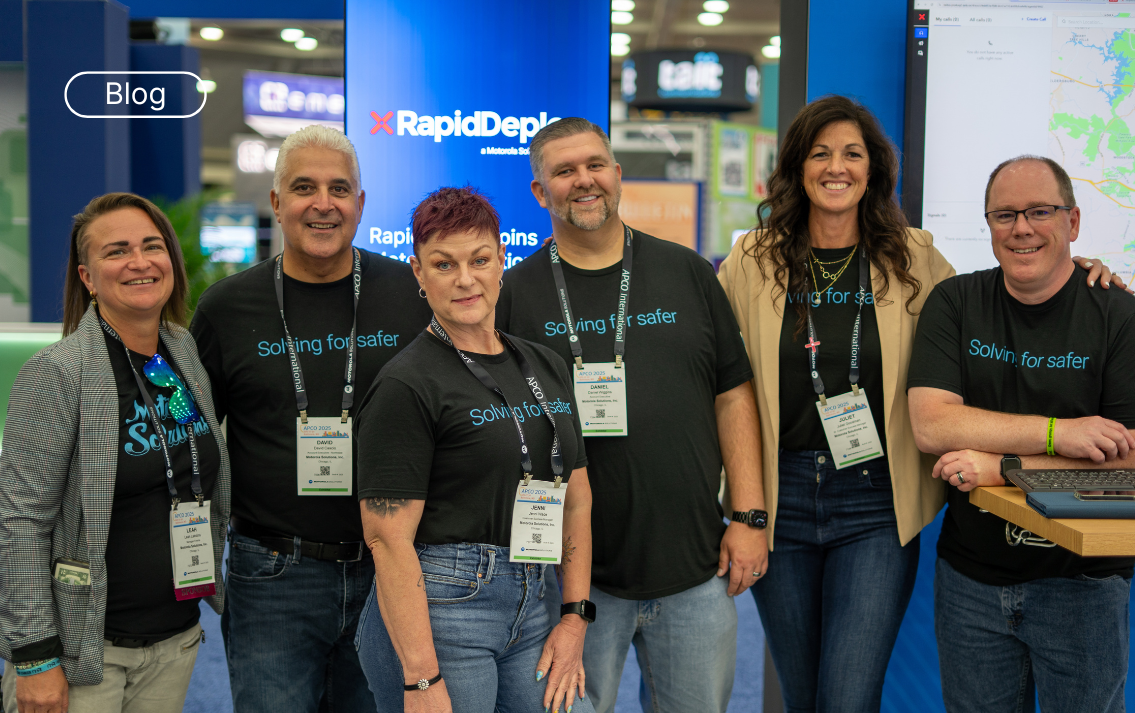
If APCO 2024 was RapidDeploy’s coming-out party, then APCO 2025 was our fully-fledged debut in the Motorola Solutions ecosystem—and what a difference a year makes.
Last year, we focused on showcasing our standalone impact on the 911 workflow. This year, we stepped onto the floor and into the Motorola Solutions booth, and our team was busy! From game-changing integrations to AI-driven demos that stopped attendees in their tracks, APCO 2025 was a glimpse into the future of public safety.
Let’s dig into our key takeaways from this year’s show, and what they mean for the 911 professionals we serve.
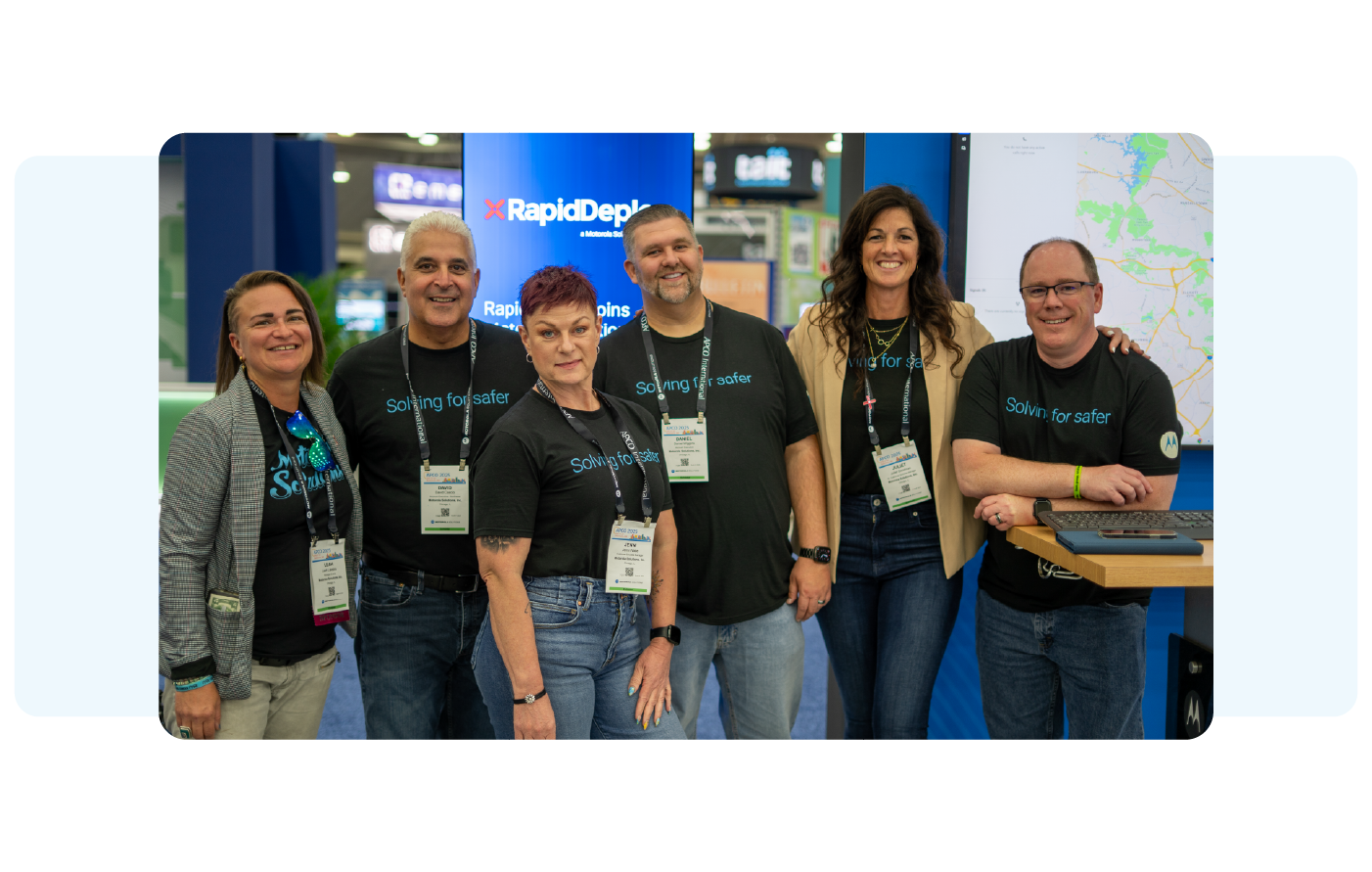
This year at APCO, Motorola Solutions shared the official integration plan for Radius Mapping into VESTA NXT, which represents a new way for telecommunicators to visualize and respond to emergencies, as Radius Mapping is now the new mapping solution for VESTA NXT.
Here’s why it matters:
The integration of Radius Mapping into VESTA NXT is a game-changer for 911 centers. By combining real-time location data, cloud-native accessibility, and a single, unified view, telecommunicators can make faster, more informed decisions without switching between systems. It’s a meaningful leap in simplifying workflows and getting help to those who need it, with speed and clarity.
We’ve heard the term “AI” tossed around a lot in public safety lately, and APCO 2025 was the year it became real.
Motorola Solutions’ Assist AI was the star of multiple demos and breakout sessions, and for good reason. This isn’t theoretical tech. It’s practical, stress-reducing AI tailored specifically for the unique demands of public safety.
Some of the biggest eye-openers included:
Assist AI represents a significant step forward in public safety technology, delivering smarter, more collaborative solutions that support emergency responders in critical moments. By streamlining workflows and reducing cognitive load, Assist empowers public safety teams to stay focused on what matters most: helping save lives. We left Baltimore convinced: the AI Assist era of 911 is here.
While the event had no shortage of fun (more on that later), the real conversations happening in sessions and on the show floor were focused on key trends shaping the next generation of emergency response:
Bottom line? Innovation that improves outcomes and reduces friction matters.
Networking is always a part of APCO, and this year had its share of unforgettable moments. RapidDeploy was proud to sponsor Nights Out events for ECC professionals from Georgia, Texas, and North Carolina, which gives these states a chance to come together to share ideas and network during APCO.
We also joined in the spirit of APCO’s night at the ballpark, where networking thrived under stadium lights. Attendees cheered as the Orioles hit multiple home runs over the walls at Camden Yards, capping the night with a historic 18-0 win.
Magic shows, boat rides, and baseball were great backdrops for deeper conversations with some of the most dedicated professionals in the country.
Motorola was proud to sponsor and host ECC tours to Baltimore City and Baltimore County 911. Getting to see a day in the life of telecommunicators at these local agencies was truly an honor.
What made this year different is how much those “casual” conversations turned into strategic discussions about implementation timelines, AI pilots, and cloud migration plans, all while enjoying Baltimore at night.

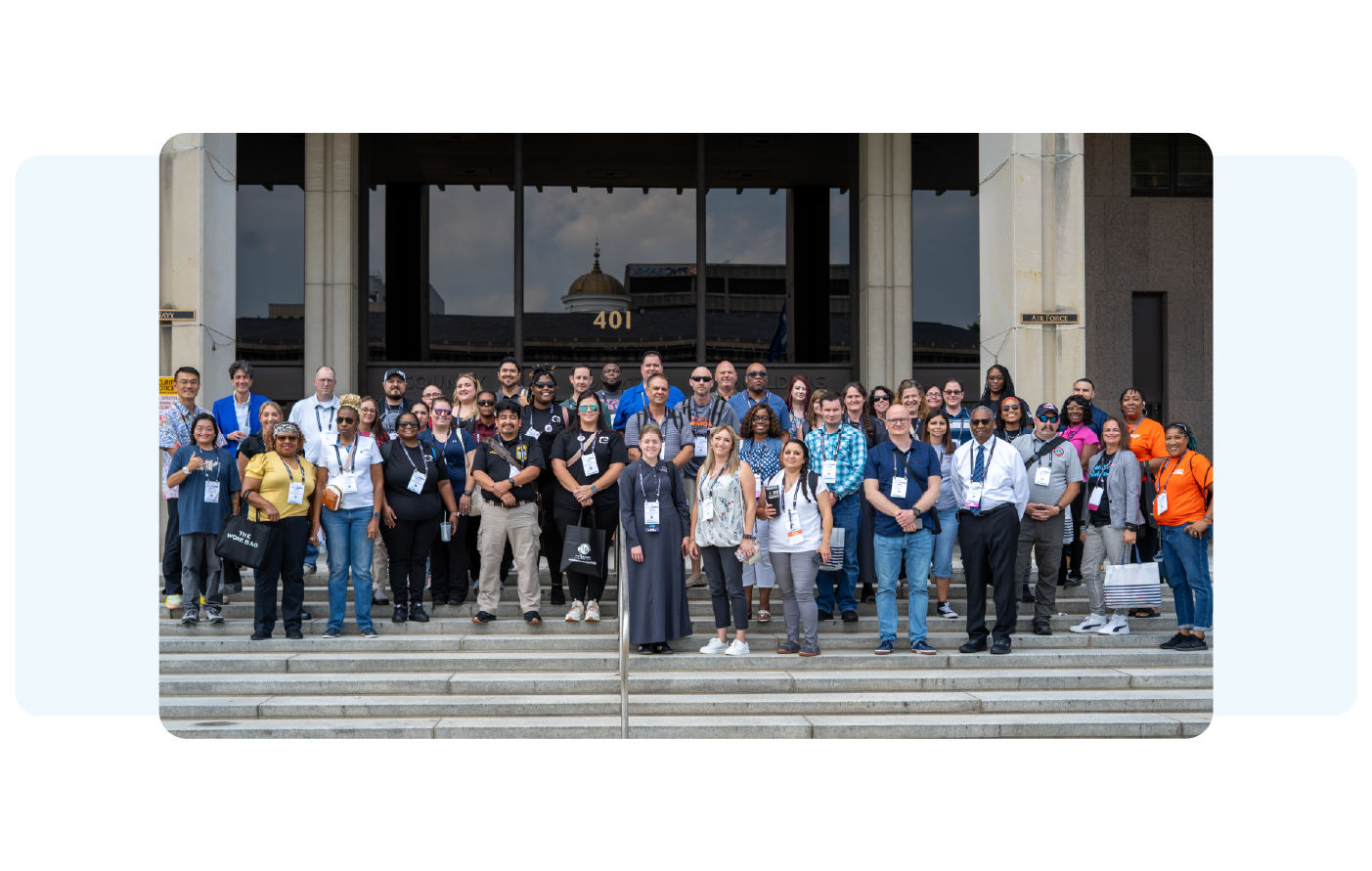
We captured some highlights - check out live footage from our live demos, product unveilings, and the incredible energy in the expo hall.
APCO 2025 confirmed what we’ve been hearing from ECCs across the country: the future of public safety is real-time, AI-assisted, and cloud-connected.
At RapidDeploy, we’re proud to be building that future as part of the Motorola Solutions family, combining innovative spirit with unmatched scale.
Want to see what’s next? Stay tuned for upcoming webinars and pilot opportunities featuring VESTA NXT + Radius Mapping and Assist AI in action.
Let us know what stood out to you at APCO 2025. We’d love to hear how your agency is preparing for the next wave of innovation in emergency response.
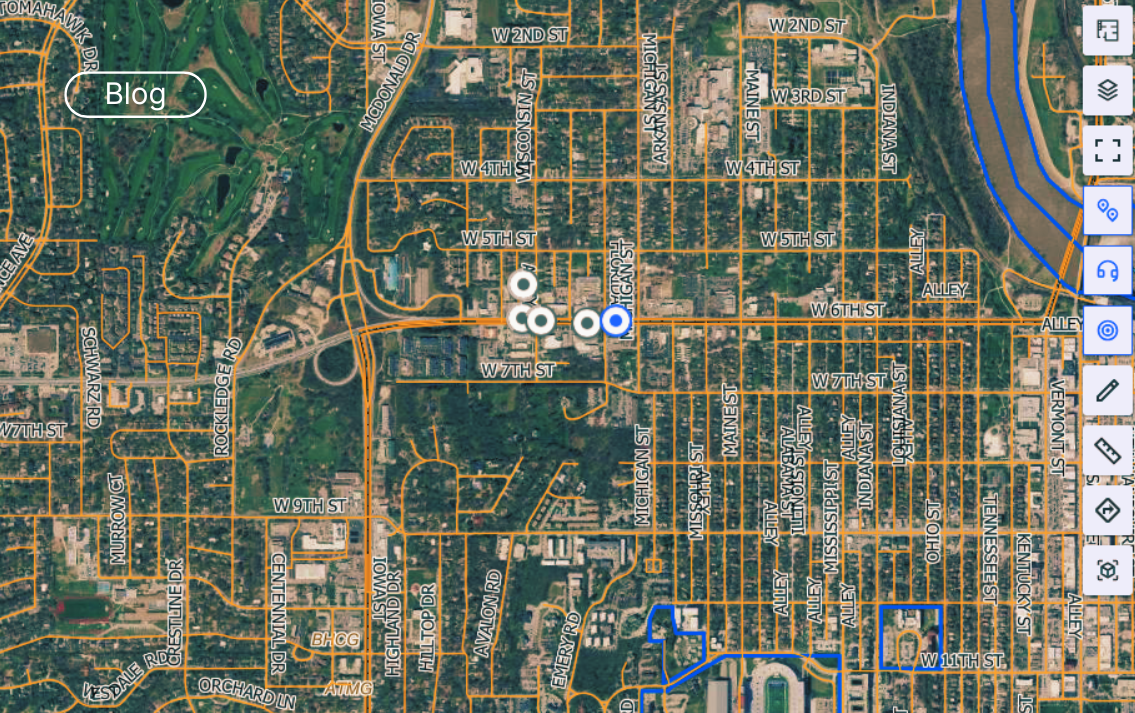
On March 15, 2025, an unexpected dust storm swept across Sherman County, Kansas, creating zero-visibility conditions on I-70, a major highway extending just over 424 miles from the Colorado border to the Missouri border. In an instant, the highway was thrown into chaos. Completely blinded by the dust, the drivers on I-70 collided with one another, resulting in a fatal 70+ vehicle pileup and leaving drivers stranded, disoriented, and in immediate danger as cars continued to collide into each other.
The Sherman County Communications team was immediately flooded with incoming emergency calls. The calls that came in needed to be managed efficiently and with care, however, many of the callers couldn’t describe their location, and several spoke different languages. To add onto the confusion and complexity, the dust storm had caused multiple crash sites, requiring responders to have very specific and exact location details in order to respond to the correct crash location.
To coordinate a timely and effective response, the telecommunicators from Sherman County turned to RapidDeploy’s Radius Mapping platform.
As calls poured in, three features within the Radius Mapping platform became critical:
Together, these features provided real-time visibility, location accuracy, and the communication clarity needed to navigate this complex, large-scale emergency. Telecommunicators were able to organize incoming calls, track the order of incidents, and coordinate response teams quickly and confidently.
For a closer look at how Sherman County Communications used Radius Mapping during this crisis, check out the full story.
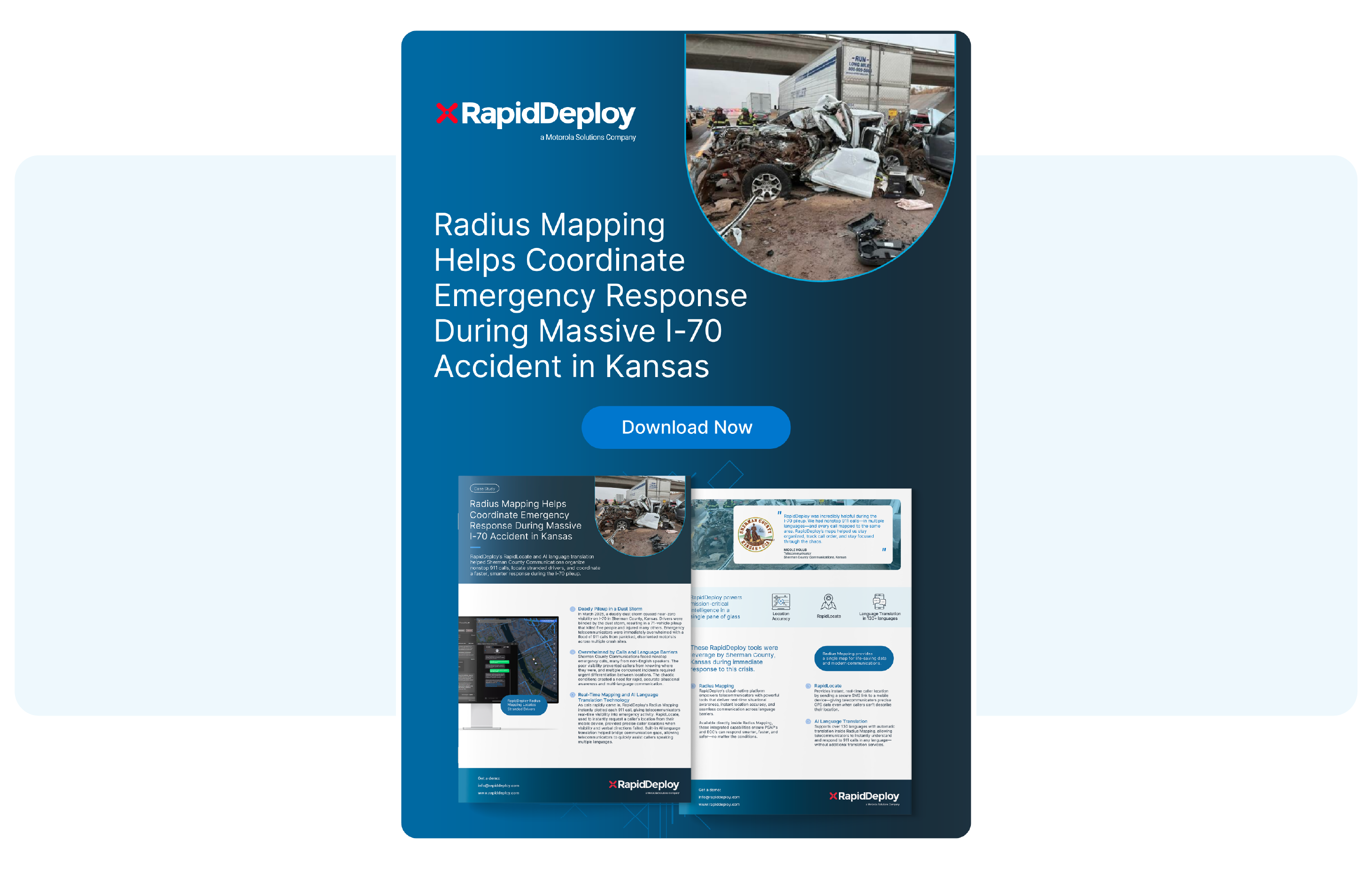
For a behind-the-scenes look, watch our exclusive video featuring Sherman County telecommunicators Crissy Livengood-Ridnour and Darcy Holmes as they share what it took to respond in the face of chaos.
The accident on I-70 isn’t the only proof of Radius Mapping’s capabilities. In Kentucky, a 911 call was received from a 15-year-old girl who was trapped on the roof of her burning home. She was confused and panicked, causing her to be unable to provide a clear address. To make matters more challenging, the call was incorrectly routed to Greenup County Public Safety.
Despite the call coming in from outside of their jurisdiction, Greenup County quickly launched the Radius Mapping platform, which provided them:
With the help of Radius Mapping and quick thinking telecommunicators, the caller was located and safely rescued without sustaining any injuries.
To read more about how Greenup County utilized Radius Mapping during this emergency response, download the case study.
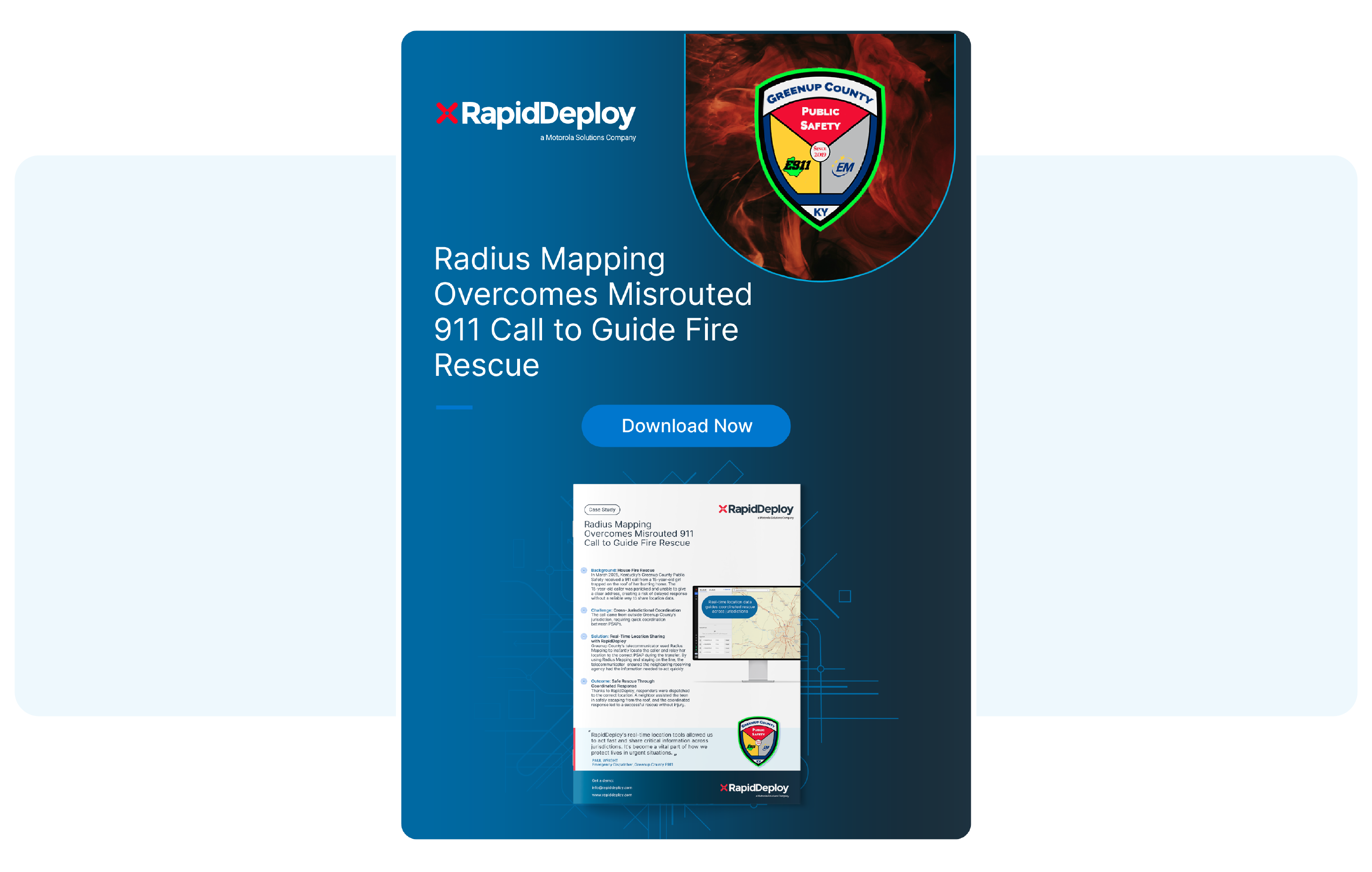
Morgan County 911 was the first PSAP in the state of Indiana to upgrade their emergency response technology with Radius Mapping. Within the first eight hours of implementing our technology, they successfully apprehended a suspect in under 10 minutes.
Watch the video to see how Radius Mapping reshaped emergency response for Morgan County 911 and why it’s earned their full approval.
From a massive dust storm on I-70 to a harrowing house fire in Kentucky, and even in the daily operations of teams like Morgan County 911, these stories are a powerful reminder that emergencies unfold fast—and responders need tools that move even faster.
Next generational 911 platforms like Radius Mapping help to locate callers who can’t describe where they are, overcome language barriers, and enable seamless coordination across agencies. This type of technology empowers telecommunicators to act with clarity, precision, and speed that helps turn uncertainty into direction and hesitation into decisive action. With the right support behind the screen, telecommunicators are better equipped to navigate the unexpected and protect their communities with confidence.
Radius Mapping has become a valuable tool in everyday emergency response. With support from RapidDeploy’s platform, telecommunicators can respond faster and with clearer information—helping them do what they do best: keep people safe.
Download the case studies to dive deeper into how agencies across the country are using Radius Mapping in the field.
Watch the video recaps to hear directly from the telecommunicators behind these life-saving responses.
Do you know a colleague or friend who has shown bravery on the frontlines? We welcome you to submit a Save Story to celebrate and honor your colleagues!
For more stories like this one and to learn about how RapidDeploy makes a difference in public safety, check out our save stories in action.

Imagine you're attending the FIFA World Cup in the U.S.—a celebration of cultures, languages, and nations coming together. But amid the cheers, chants, and cultural fusion, you witness someone collapse, and instinctively you call 911. But your phone number is an international phone number. What happens next might surprise you.
This is not a theoretical scenario. For emergency communication centers (ECCs), handling calls from international numbers during large-scale events has become a critical blind spot in our current 911 infrastructure. And as cities gear up to host massive global events like the FIFA World Cup, parades, or international festivals, it’s a challenge we can’t afford to ignore.
During a recent conversation between RapidDeploy’s VP of Marketing and the Chief Innovation Officer at North Central Texas 9-1-1, an interesting discussion emerged: international numbers present systemic problems for U.S. emergency response infrastructure.
Here’s why:

This technical disconnect becomes a public safety hazard when you scale it to the size and diversity of global events. The FIFA World Cup is projected to bring millions of international visitors to the U.S. The majority will rely on their foreign mobile carriers and phone numbers.
In emergency scenarios:
The result? Potentially thousands of emergency calls that can’t be properly identified, located, or followed up on—putting lives at risk.
Interested in learning more about managing the complexities of emergency response during live events? Download RapidDeploy's Ebook.

Thankfully, this isn't a problem without a solution. Next Generation 911 (NG911) technologies, like RapidDeploy's Radius Mapping, can help address this issue.
Radius Mapping operates as an over-the-top (OTT) solution, independent of the limitations of the legacy 911 core infrastructure. Here’s how it solves the problem:
In essence, Radius Mapping acts as a translator and amplifier for outdated 911 systems, ensuring ECCs can see, hear, and respond to every caller, regardless of their cell phone’s origin.
With major global events on the horizon, addressing this challenge is not only an operational upgrade, but also a critical matter of public safety and international accountability. Cities within the U.S., and especially those that host live, large events with complex emergency response challenges, must be able to serve all people within its borders who dial 911 for help, not just those with domestic phone numbers.
Without addressing these challenges, public safety agencies may face operational gaps during critical incidents. More importantly, it can impact the reliability and inclusivity of our emergency response system, especially in situations involving international visitors.
Want to dive deeper into the topic of how to keep callers safe? Download our 2-page guide to learn more.

If you are a leader in public safety, now is the time to audit your systems:
As emergency response continues to evolve, it’s important to build systems that are both flexible and inclusive. With large international events on the horizon, ensuring that 911 systems can support a wide range of callers, regardless of their phone number or location, will help responders serve communities more effectively and equitably.

In December 2024, a 911 call came from a panicked father in Sullivan County, Tennessee. His 7-month-old baby was having trouble breathing. On the other end of the line, Wendy Doran, a telecommunicator with the Sullivan County Sheriff’s Office, immediately sensed that this wasn’t a moment for guesswork and that she needed to both hear and see with her own eyes what was going on at the scene.
As the father struggled to describe what was happening, Wendy made a critical decision. She quickly launched RapidVideo, a one-way live video feature within RapidDeploy’s Radius Mapping platform. In seconds, she sent a secure video link to the caller’s phone, allowing her to see the baby’s condition for herself.
That visibility changed everything. Through the video feed, Wendy coached the father step by step—first instructing him to use a bulb syringe to clear the baby’s airway, then guiding him through infant CPR. Just before First Responders arrived, the baby began to breathe again.
The advanced capabilities of RapidDeploy’s Radius Mapping platform played a vital role in this life-saving response. By enabling Wendy to launch a live, one-way video call through RapidVideo, she gained immediate visual insight into the baby’s condition—turning uncertainty into action. Her ability to interpret what she saw and guide the caller in real time highlights how powerful NG911 tools become when paired with the intuition and composure of a skilled telecommunicator. You can read more on this story by downloading the case study.

For her extraordinary response, Wendy was named the Q2 2025 RapidDeploy Superstar Award winner—an honor given to 911 professionals who go above and beyond in critical moments by leveraging RapidDeploy’s technology to deliver life-saving outcomes. She was also recognized earlier this year by her agency with the Sullivan County Lifesaving Award.
On May 19, 2025, public safety leaders joined the Sullivan County Sheriff’s Office to celebrate Wendy’s heroic actions during a local awards ceremony, honoring both her courage and her exemplary use of NG911 tools in the field.
“Wendy didn’t just use RapidVideo—she used it exactly the way it’s meant to be used: to help save a life when there’s no room for error,” said Steve Raucher, co-founder of RapidDeploy. “We’re incredibly proud to recognize her as a Superstar.”

Wendy’s story shows how live video can guide life-saving actions in real time. In another emergency earlier this year, RapidVideo was used by another 911 agency to handle a fire-related emergency. When a caller from Pima County, Arizona reported a residential fire might be spreading to a nearby structure, the Valley Emergency Communications Center (VECC) telecommunicators used RapidVideo to gain real-time visual confirmation of the situation. By quickly assessing the footage within RapidDeploy’s Radius Mapping platform, they were able to provide accurate insights to the Battalion Chief—resulting in a decision to downgrade the response. Rather than dispatching seven emergency vehicles, only the closest engine continued with lights and sirens engaged.
The result? Improved safety for responders, reduced public risk, and smarter allocation of limited emergency resources.
“RapidVideo was able to inform our PSAP and command staff with timely, relevant information that ultimately aided in leveraging the proper, safe response to the incident,” said Jason Moore, Deputy Chief and Director of VECC.
Download the Arizona RapidVideo case study here.

These two incidents—one involving an unresponsive infant, the other a potential structure fire—highlight the versatility and power of RapidVideo. Whether guiding CPR during a high-stakes medical call or helping downsize a fire response to avoid unnecessary risk, RapidVideo delivers critical situational awareness exactly when it's needed most.
Wendy’s story is a powerful reminder of the life-saving difference 911 professionals can make when equipped with advanced technology that delivers real-time insight and supports fast, informed action in the most critical moments.
Watch the full award presentation, held at the Sullivan County Sheriff’s Office in Tennessee, and see behind-the-scenes moments from Wendy’s recognition event in our video recap below:
Do you know a colleague or friend who has shown bravery on the frontlines? We welcome you to submit a Save Story to celebrate and honor your colleagues!
For more stories like Wendy's and to learn about how RapidDeploy makes a difference in public safety, check out our save stories in action.

On May 15th, 2025, the Kansas 911 Coordinating Council officially unveiled their latest innovation: the Emergency Mobile Dispatch Training Center (EMDTC). During a ribbon cutting ceremony in Salina, Kansas, the Kansas 911 Coordinating Council celebrated the roll-out of the first vehicle dispatch unit with emergency response capabilities. The EMDTC represents Kansas' vision to:
As part of Motorola Solutions, RapidDeploy is proud to support Kansas in this effort—working collaboratively to ensure emergency communications are more resilient, mobile, and interoperable than ever before.
Watch the Recap! Check out the highlights from the ribbon cutting ceremony in our event video below—and see how Kansas is driving the future of public safety.
The EMDTC represents Kansas’ commitment to meeting public safety challenges with practical, future-ready solutions.
This climate-controlled vehicle is equipped with:
The unit is always deployment-ready, whether to fill a gap during a 911 center outage, support public safety at large community events, or provide hands-on training where it’s most needed.
“This unit allows us to provide essential training and operational assistance wherever it’s needed—whether supporting 911 centers during crises or conducting live exercises in local communities,” said Sherry Massey, Executive Director of the Kansas 911 Coordinating Council.

With more than 100 PSAPs serving every county in Kansas, the ability to scale resources and adapt quickly is critical to maintaining reliable emergency communications across the state.
Kansas regularly supports large-scale events—such as festivals, fairs, and community gatherings—and responds to significant natural disasters, including wildfires, windstorms, and severe winter blizzards. These scenarios require rapid coordination, real-time information sharing, and seamless collaboration across jurisdictions.

The EMDTC addresses these challenges head-on. As a mobile, fully equipped dispatch and training center, it provides on-demand capacity wherever it’s needed—enhancing operational continuity, field training, and incident support in dynamic, high-pressure environments. Paired with tools like RapidDeploy’s Radius Mapping and ECC Messaging, Kansas responders can maintain real-time situational awareness and engage with multiple agencies efficiently, even in fast-moving, multi-jurisdictional incidents.
Beyond its immediate operational value, the EMDTC also represents a forward-looking investment in Kansas' 911 infrastructure. As the state transitions from the 911 Coordinating Council to the formal State 911 Board in July of this year, the unit reflects a broader commitment to building a cohesive, modern emergency response system—one that prioritizes accessibility, interoperability, and statewide resilience.
The Emergency Mobile Dispatch Training Center is the result of strong, strategic partnerships across the public safety ecosystem which are built on shared values and a collective commitment to advancing emergency response throughout Kansas. By working together, industry leaders including Motorola Solutions, RapidDeploy, AT&T, and FirstNet® have made it possible for the state to extend its NG911 capabilities beyond the walls of traditional PSAPs.
These partnerships together deliver a dependable, integrated emergency response framework. With Motorola Solutions’ call handling, mapping, and reporting software, AT&T’s FirstNet network delivering reliable and prioritized connectivity, and RapidDeploy’s cloud-native platform for situational awareness and response, the EMDTC mirrors the functionality of Kansas’ fixed 911 infrastructure—within a fully mobile, rapidly deployable unit.
Through the deployment of Motorola Solutions and RapidDeploy’s software suite—including Radius Mapping, Eclipse Analytics, and the Lightning mobile app—the state is equipped to deliver real-time, coordinated emergency communication across jurisdictional boundaries.

While the EMDTC offers state-of-the-art hardware, its deeper value lies in how it enhances field collaboration and supports continuity of service during both planned events and unexpected disruptions. It ensures that responders have access to the same high-performing technology they rely on in traditional 911 centers—wherever they are.
A key part of that ecosystem is RapidDeploy’s Lightning mobile app, available to Kansas field responders. Lightning complements the EMDTC by enabling:
This level of interoperability and mobility empowers agencies to scale their operations quickly and respond with greater precision during critical incidents.
“Kansas 911 is building a more resilient, next generation emergency response infrastructure to better serve residents across the state,” said Todd Piett, senior vice president of Command Center Solutions at Motorola Solutions. “Motorola Solutions is proud to support Kansas with statewide deployments of our call handling, mapping, and reporting software technology as well as our Lightning mobile app for field responders. The EMDTC is truly a forward-thinking approach to emergency response, facilitating hands-on training for agencies across a powerful technology suite to help accelerate response times.”
As the designated communications platform for public safety, FirstNet ensures prioritized, reliable connectivity for the EMDTC during deployments—whether supporting a local fair or disaster recovery. And as part of a landmark statewide initiative, AT&T continues to support Kansas in building a modern emergency response infrastructure that is scalable, resilient, and ready for the demands of tomorrow.
Together, these integrated technologies and trusted partnerships are making mobile emergency response a reliable, scalable, and future-ready capability for public safety agencies across Kansas.
The ribbon-cutting ceremony marked the launch of Kansas’ first EMDTC and reaffirmed Kansas’ long-term commitment to improving emergency response statewide.
We’re honored to support this next step in Kansas’ public safety evolution. The EMDTC reinforces what’s possible when forward-thinking leadership works hand-in-hand with technology partners who share a commitment to reliability, accessibility, and training excellence.
To learn more about how Kansas continues to lead in NG911 innovation, visit kansas911.org and follow the EMDTC’s journey as it delivers high-impact support to communities across the state.

California’s public safety landscape is one of the most complex in the nation. From devastating wildfires and earthquakes to high-density urban emergencies and large-scale public events, agencies across the state face an extraordinary range of threats—all within an expansive geography of over 163,000 square miles.
In 2024, the California Governor’s Office of Emergency Services (Cal OES) emphasized that interoperability and real-time data sharing are no longer aspirational goals for the state—they are foundational requirements for a modern emergency response infrastructure. This recognition has fueled a statewide focus on solutions that connect emergency teams across jurisdictions, platforms, and disciplines.
California’s transition to Next Generation 911 is not just happening inside Public Safety Answering Points (PSAPs)—it's now reaching the field. To help bring a vision of shared data across all public safety entities to life, Cal OES selected RapidDeploy’s Lightning Mobile App as a technology to help support California’s interoperability and real-time data sharing strategy. Lightning, powered by RapidDeploy’s Radius Mapping platform, delivers mission-critical data directly to first responders’ smartphones and tablets, enabling faster, more informed decisions when seconds matter most. With statewide access now available, California PSAPs can equip their field responders with Lightning—providing the same data available in the PSAP to the front lines to enhance officer safety, communication, and situational awareness.
Lightning offers precise caller location, real-time tracking of responder positions, incident data, and modern communication tools in a single, easy-to-use app and is designed for law enforcement, fire, EMS, and emergency management teams statewide.
California Police Sergeant Steven Puryear from the Reedley Police Department emphasized the app’s immediate usability:
“I didn’t even have to teach my officers how to use the Lightning Mobile App. They figured it out on their own with little to no help. I’m not the most tech-savvy person, but this solution is incredibly user-friendly, and I appreciate that it keeps me logged in and ready to go at all times.” - Sergeant Steven Puryear, Special Response Team, Reedley Police Department, California

This low barrier to entry translates directly into immediate operational benefits—and can help save critical seconds when lives are on the line. Agencies don’t need to invest in extensive training or onboarding—teams can activate and benefit from Lightning immediately.
When someone dials 911, they’re not just requesting assistance—they’re reaching out in a moment of fear, urgency, or crisis. And in over 80% of cases, that call comes from a mobile device, not a landline. The ability to locate the caller precisely—especially when they can’t articulate where they are—is a powerful advantage of modern public safety technology.
That’s where Lightning can make a huge impact. Built to extend Next Generation 911 capabilities into the field, the Lightning Mobile App empowers California’s first responders with real-time caller location, live visual context, and immediate proximity alerts—right in the palm of their hands.
“We had a 911 call come in for a domestic violence incident at a large business. Dispatch couldn’t specify exactly where the caller was located, but one of my officers opened the Lightning Mobile App and pinpointed her location instantly. It saved us valuable time and made the search straightforward.”
- Sergeant Steven Puryear, Reedley Police Department

Together, Lightning helps ensure that callers in crisis can be located, understood, and protected—faster and more effectively than ever before. Download our caller safety guide to learn more.

The benefits of shared data goes far beyond pinpointing a caller’s location. Lightning’s precise location capabilities can increase situational awareness, allowing officers to see one another’s positions on the map in real time, giving them a shared, dynamic view of the unfolding incident. This kind of shared visibility turns situational awareness into real-time collaboration—enabling coordinated action without the noise of traditional communication gaps. Sergeant Steven Puryear, Reedley Police Department, recalled an incident where “during a stolen car call, we used the app’s AVL feature to coordinate seamlessly in the field. Without needing to rely on constant radio communication, we split up based on our mapped locations and quickly tracked down the car. The app made teamwork effortless.”

By showing responder locations, caller locations, and incident data all on one screen, Lightning creates a live operational map that helps responders make smarter split-second decisions. Officers can reroute based on unfolding activity, provide backup to nearby units, and avoid overlap or missed coverage—all without needing to check in manually. This level of situational awareness is especially critical in high-stakes, fast-moving incidents like pursuits, large event coverage, or natural disaster response. And because Lightning integrates seamlessly with Radius Mapping, responders are always working from the most current, complete picture—together, not in silos.
In high-risk and high-uncertainty situations, visibility into responder locations and access to real-time information can mean the difference between control and chaos—or safety and vulnerability, for officers, responders, and citizens.
Lightning empowers teams with real-time responder tracking, dynamic incident views, and instant alerts when emergencies occur nearby. With these tools, command staff and on-the-ground units can quickly assess risk, adjust response strategies, and provide immediate backup when an officer is at risk. Sergeant Steven Puryear, Reedley Police Department, shared this recent experience with Lightning:
“On a drive-by call, I used the Lightning Mobile app to check one of my officer’s locations and realized he was in a vulnerable position, alone. The app allowed me to immediately send backup and adjust his location to a safer spot. That kind of real-time awareness has made a huge difference in how we ensure officer safety.”
NG911-enabled tools like Lightning help eliminate safety gaps by extending authoritative mapping data and indoor and outdoor floor plans directly to field responders.
Lightning also integrates with RapidVideo and CCTV feeds, offering situational context before a responder even steps on scene—vital during high-risk calls such as active threats, domestic violence, or unknown hazards.
Lightning is part of a broader vision—one that puts shared data at the core of California’s emergency response strategy.
Available to all Radius Mapping users, ECC Messaging enables real-time, multi-agency chat across Emergency Communications Centers (ECCs). Whether coordinating during a natural disaster, multi-jurisdictional pursuit, or large public event, ECC Messaging ensures teams across regions can share information instantly and clearly—cutting down on miscommunication and increasing operational alignment.

Another data sharing tool, Exchange Link, integrates Rave Mobile Safety’s Rave Link with RapidDeploy’s Radius Mapping, allowing agencies to securely share CAD incident data, unit locations, and resource requests in real time—directly through a unified interface. With a customizable rules engine, agencies can control what information is shared, when, and with whom.
Together, ECC Messaging and Exchange Link align with California’s Data Information Sharing Initiative (CAL DIS) and Next Generation 911 (NG911) standards, building the state’s foundation for a more connected, resilient emergency response system.
California’s public safety agencies operate in one of the most demanding emergency response environments in the country. From active wildfires and devastating earthquakes to densely populated urban incidents and cross-jurisdictional pursuits, responders must act fast—and act together.
That’s why Cal OES has made interoperability and shared data cornerstones of its CAL DIS initiative. The Lightning Mobile App is a powerful extension of that vision—bringing real-time, actionable intelligence directly into the hands of field responders and bridging the data gap between ECCs and the front lines.
With caller and responder location, live video streams, indoor maps, interagency chat, and incident boards all accessible in one intuitive interface, Lightning simplifies the way data moves and is shared in emergencies. It helps agencies work smarter, coordinate faster, and keep both responders and the public safer.
As Sergeant Steven Puryear of the Reedley Police Department puts it:
“The Lightning Mobile App has been a game-changer for our team. It streamlines our workflows, improves communication, and gives us tools to respond smarter and faster. It’s a solid app that’s already made an impact in the field.”

From remote regions to crowded cities, Lightning helps to enable a new standard of shared situational awareness that aligns with NG911 goals and supports a long-term interoperability strategy.